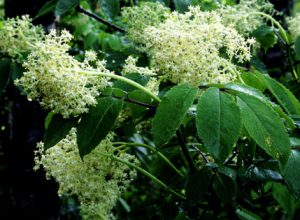Bulletin #2581, Native Trees and Shrubs for Maine Landscapes: Scarlet Elder (Sambucus racemosa var. pubens)
Developed by Marjorie Peronto, Associate Extension Professor, University of Maine Cooperative Extension; and Reeser C. Manley, Assistant Professor of Horticulture, University of Maine.
For information about UMaine Extension programs and resources, visit extension.umaine.edu.
Find more of our publications and books at extension.umaine.edu/publications/.
Go native!
This series of publications is the result of a five-year research project that evaluated the adaptability of a variety of native trees and shrubs to the stresses of urban and residential landscapes in Maine. Non-native invasive plants pose a serious threat to Maine’s biodiversity. Plants such as Japanese barberry, shrubby honeysuckle, and Asiatic bittersweet, originally introduced for their ornamental features, have escaped from our landscapes, colonizing natural areas and displacing native plants and animals. By landscaping with native plants, we can create vegetation corridors that link fragmented wild areas, providing food and shelter for the native wildlife that is an integral part of our ecosystem. Your landscape choices can have an impact on the environment that goes far beyond your property lines.
Description

Form: a multi-stemmed shrub with leggy, upright, spreading branches
Size: 6 to 12 feet high and wide
Ornamental characteristics:
- spikes of small, white flowers in early to late May
- clusters of brilliant red berries from late June through late July
- striking winter form in plants pruned as small trees
Landscape Use
Scarlet elder belongs in the cool, moist woodland landscape beneath the canopy of yellow birch (Betula alleghaniensis) and sugar maple (Acer saccharum), keeping company with beaked filbert (Corylus cornuta), roundleaf dogwood (Cornus rugosa), and mapleleaf viburnum (Viburnum acerifolium). With a minimum of effort, you can prune scarlet elders to form small, open-branched trees. Groupings of artfully pruned plants add a great deal of structural interest to the winter woodland landscape.

Sambucus racemosa var. pubens produces flowers and fruits earlier than its better-known relative, American elder (S. canadensis). The two can be grown together, the bright red berries of scarlet elder mingling with American elder’s flat-topped clusters of creamy white flowers.
Because scarlet elder is not tolerant of most environmental stresses associated with managed landscapes, avoid using it in seasonally flooded areas, in sites exposed to deicing salts, or in sites surrounded by paving or buildings that intensify summer heat. Also, provide scarlet elder with water in summer droughts.
Culture
Hardiness: USDA zone 3a

Soil requirements: prefers moderately to well-drained soils
Light requirements: very shade-tolerant
Stress tolerances:
soil compaction — intolerant
pollution — intolerant
deicing salts — intolerant
urban heat islands — intolerant
drought — intolerant
seasonal flooding — very intolerant
Insect and disease problems: none serious
Wildlife Value
The fruits of S. pubens are poisonous to humans; however, they are eaten safely by many bird species, including red-eyed vireos, woodland thrushes, catbirds, and upland game birds, as well as by large and small mammals.
Maintenance
Irrigation: Water shrubs regularly for at least one year after planting. Apply 1 inch of water over the root zone once a week until leaves fall in autumn: in general, a shrub’s root zone extends twice as wide as its canopy. Once established, plants should survive even when no rain falls for up to two weeks. Keep soil moist by watering thoroughly once per week when needed.
Fertilization: Landscape trees and shrubs should not be fertilized unless a soil test indicates a need. Correct soil pH, if necessary, by amending the backfill soil. No nitrogen fertilizer should be added at planting or during the first growing season.
To learn more about native woody plants
Visit the Eastern Maine Native Plant Arboretum at University of Maine Cooperative Extension’s Penobscot County office, 307 Maine Avenue in Bangor. Established in 2004, the arboretum displays 24 different native tree and shrub species that can be used in managed landscapes.
Reviewed by Cathy Neal, Extension professor, University of New Hampshire Cooperative Extension.
Photos by Reeser C. Manley.
Illustration by Margery Read, Extension Master Gardener.
 This series of publications and the associated research were made possible in part by the Maine Forest Service’s Project Canopy.
This series of publications and the associated research were made possible in part by the Maine Forest Service’s Project Canopy.
Information in this publication is provided purely for educational purposes. No responsibility is assumed for any problems associated with the use of products or services mentioned. No endorsement of products or companies is intended, nor is criticism of unnamed products or companies implied.
© 2008
Call 800.287.0274 (in Maine), or 207.581.3188, for information on publications and program offerings from University of Maine Cooperative Extension, or visit extension.umaine.edu.
The University of Maine is an EEO/AA employer, and does not discriminate on the grounds of race, color, religion, sex, sexual orientation, transgender status, gender expression, national origin, citizenship status, age, disability, genetic information or veteran’s status in employment, education, and all other programs and activities. The following person has been designated to handle inquiries regarding non-discrimination policies: Sarah E. Harebo, Director of Equal Opportunity, 101 North Stevens Hall, University of Maine, Orono, ME 04469-5754, 207.581.1226, TTY 711 (Maine Relay System).

